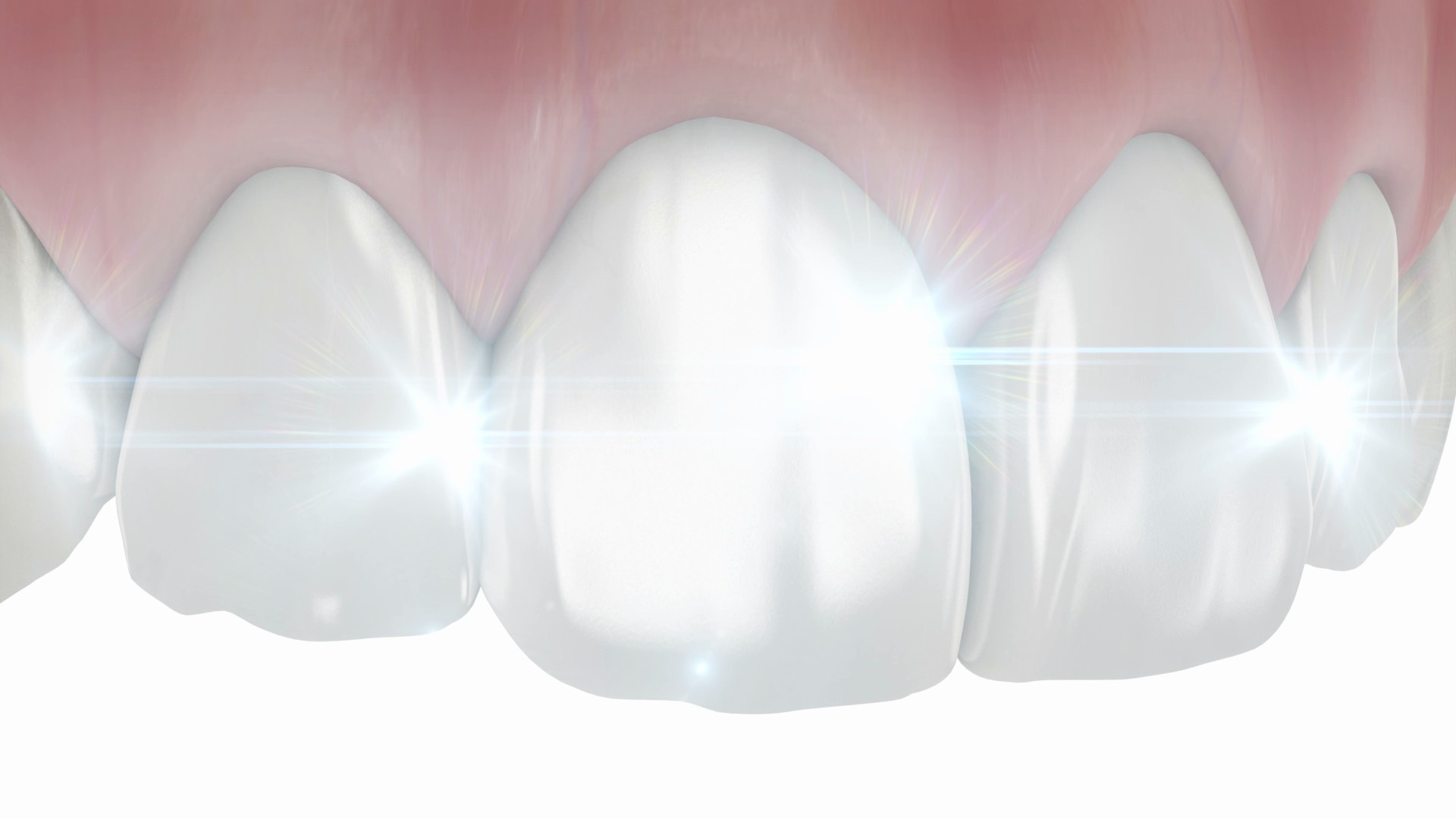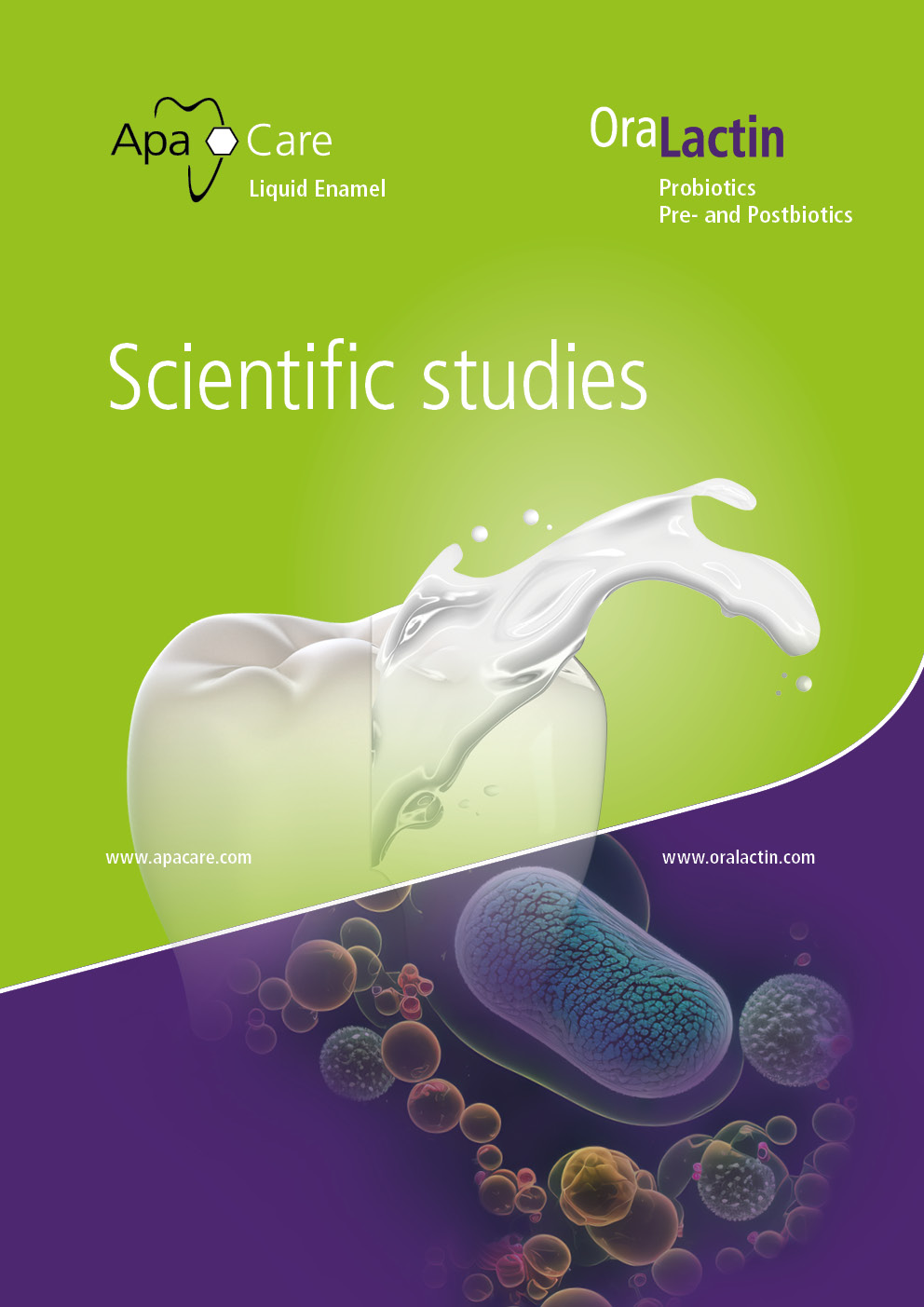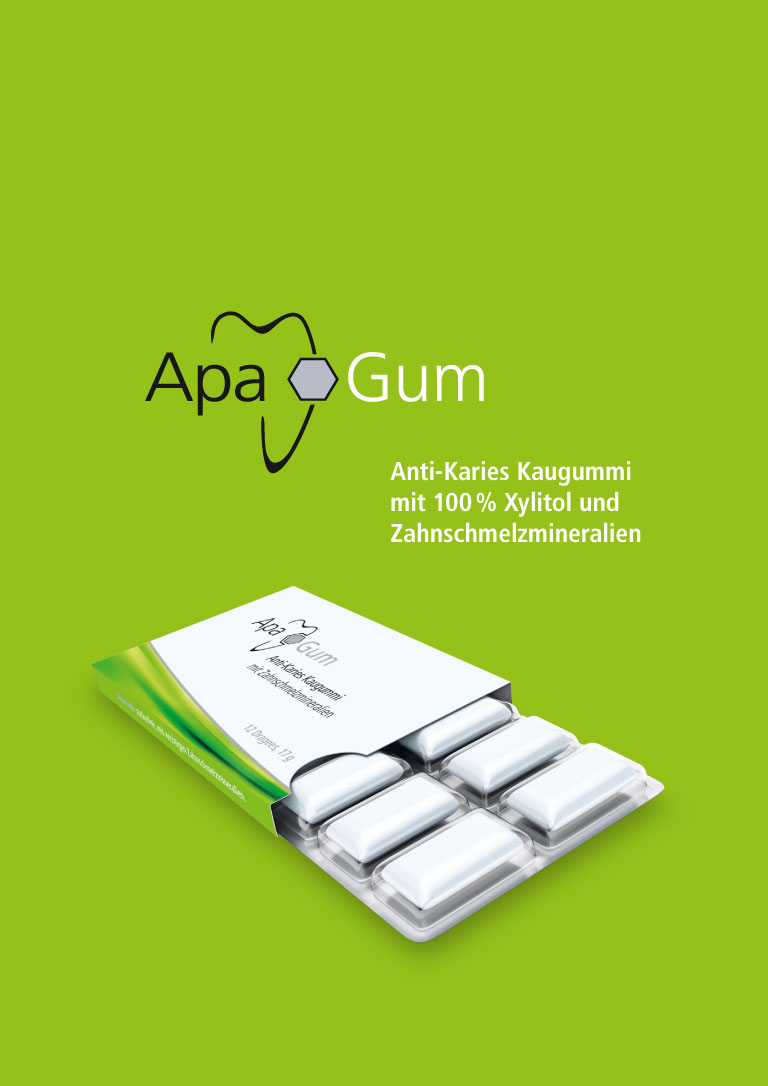ApaCare toothpaste combines liquid enamel with fluoride in a unique preventive formulation. The liquid enamel forms a shiny white, particularly smooth protective layer on the tooth surface, which is reinforced by the fluoride effect and builds up the tooth in the long term.
The ApaCare active principle
Our teeth.
What they do. What they need.
Liquid enamel:
rejuvenation for the teeth
rejuvenation for the teeth



The ApaCare active principle
What is liquid tooth enamel?
Tooth enamel is the hardest substance in the human body. Throughout its life, it interacts with its environment, saliva and nutrition.
Sweet, carbohydrate-rich and acidic foods dissolve the enamel surface, the natural saliva minerals build up the enamel again and again.this natural build-up can be supported by the fluorides.
In addition to fluoride, ApaCare® dental care products also contain liquid tooth enamel, so-called medical hydroxyapatite. This binds directly to the tooth surface with every ApaCare application. In this way, the liquid enamel fuses with the tooth surface, hardens it, smoothes it, makes it shiny, covers it with a protective layer and repels pathogenic bacterial plaque and discoloration.
ApaCare for gleaming white teeth
ApaCare® toothpaste - a modern toothpaste
ApaCare® toothpaste - effect and prophylaxis
ApaCare® „What is liquid tooth enamel?“
FAQ`s about ApaCare
Liquid enamel refers to microfine apatite crystals, the basic material of our teeth. All ApaCare dental care products contain these enamel crystals, which adhere to the tooth surface like a magnet. Liquid enamel forms a shiny white, very smooth protective layer on the tooth surface and builds up the tooth in the long term.
The ApaCare protective layer also has an effect on the inside of the tooth: the tooth surface becomes denser and thus more resistant. Pores or early caries can be regressed to the point of hardening chalk teeth.
Fluoride from the toothpaste reacts with the natural calcium in saliva on the tooth surface to form an invisible remineralization (calcium fluoride) layer. From this layer, the calcium enters the tooth and remineralizes it. Tooth minerals, which are daily dissolved out of the tooth by acids or wear during chewing, can thus be reincorporated and bond with the tooth. Unfortunately, the calcium fluoride layer is only stable for a short time and is broken down again during chewing. Thus, the toothpaste that you use every day is a very good carrier of fluoride, especially since you also brush longer than you rinse, for example, and thus give the fluoride time to react.
Fluoride is closely related to chloride, our essential table salt. Both are salts, occur naturally and have nothing to do with fluorine or chlorine gas. Both are very important for the organism, fluoride also for bone formation.
There are sensible quantity limits for both and within those with a high tolerance there is no evidence of toxic effects for adults and also not for children.
This is exactly what ApaCare does by cleverly stabilizing the hydroxyapatite. Fluoride and hydroxyapatite reinforce each other in their remineralizing effect. In addition, the hydroxyapatite, which chemically consists primarily of calcium, provides another source of calcium, which is particularly important in cases of dry mouth with low salivary flow and thus low salivary calcium.
ApaCare toothpaste has a mild freshness and tastes good. With 1450ppm fluoride, it is suitable for all ages.
Very young children up to 3 years old brush 2 times a day with a lentil-sized amount of toothpaste.
Children 3 to 6 years old brush 2 times a day with a pea-sized amount.
From 6 years, use ApaCare toothpaste 2 times a day with a normal length.
All ApaCare products do not contain aggressive soaps and wetting agents and are therefore particularly gentle and kind to the gums and sensitive oral mucosa. This reliably prevents intolerances such as blistering or detachment of the superficial mucosal layer.
Why do modern toothpastes like ApaCare avoid titanium dioxide?
Titanium dioxide was (and is) widely used as a whitening agent in toothpastes, cosmetics and foods. Titanium dioxide (E171) has been banned EU-wide for food since mid-2022 as a result of the nano discussion, but is actually still allowed for cosmetics such as toothpaste.
All ApaCare products can easily do without titanium dioxide, since liquid tooth enamel contains a brilliant natural whitener.
400 toothpastes in test: Every second one fails
Only a few tubes contain sufficient ingredients and active ingredients
Tübingen, 03/2019 - If the toothpaste delivers what it promises, it comes out on top in the test conducted by the consumer magazine Öko-Test. However, just 116 out of 400 toothpastes that have now been examined by Öko-Test in terms of their ingredients and effectiveness manage to do so. The unpleasant result: Many pastes contain no or too little fluoride, which is why the products do not offer optimum protection against caries. But there are exceptions.
Good dental care prevents dental problems such as caries, periodontosis or even tooth loss and is probably the most im- portant element of healthy oral hygiene. For this it requires a good toothpaste full active substances - and of it gives it by far less, than with the view into the full drugstore shelves thought. The independent consumer magazine Öko-Test has now published that only 119 of 400 toothpastes tested by Öko-Test for ingredients and active ingredients scored ‚very good‘ and only 27 scored ‚good‘. Many toothpastes do not deliver what they promise on the tube.
The biggest shortcoming of the 200 or so products that failed the test was their lack of fluoride content. Fluoride has been proven to prevent caries and should therefore be contained in good toothpastes. For example, dental guidelines recom- mend a fluoride content of 1000 to 1500 ppm (grams per kilogram) for adult toothpaste, with brushing with the fluoride- containing toothpaste at least twice a day[1].
Best caries prophylaxis through a combination of active ingredients in a tube
An even stronger preventive effect against caries is achieved by combining fluoride with the artificial tooth enamel known as hydroxyapatite, which has only recently become available in toothpastes[2]. Like fluoride, hydroxyapatite has a reminera- lizing effect and thus protects the tooth structure, which consists of a large number of minerals and crystals. During remine- ralization, fluoride and hydroxyapatite are incorporated into the smallest cracks and defects in the enamel and underlying dentin. Teeth become stronger and more resistant, tooth sensitivity decreases noticeably, teeth feel smooth and clean. Most importantly, remineralization also significantly reduces the incidence of caries. Caries bacteria find less of a foothold on the tooth surface, where they can colonize: „Artificial tooth enamel, such as the crystalline mineral hydroxyapatite, has been re- searched by us for many years as a tooth-protecting substance. Hydroxyapatite is 95 percent structurally identical to the real enamel of the teeth and has only recently become available in combination with the proven fluoride in a single toothpaste. The two substances have an additive effect. In combination, therefore, there is a double remineralization effect and thus double protection against caries,“ explains dentist and dental entrepreneur Prof. Dr. Rainer Hahn from Tübingen.
Grade very good for hydroxyapatite and fluoride
So it‘s no wonder that Öko-Test gave the ApaCare® toothpaste developed by the dentist a rating of ‚very good‘. ApaCare® contains 1450 ppm sodium fluoride and hydroxyapatite in a patented combination of active ingredients. It is currently the only toothpaste that combines both ingredients..
More on the test results can be read on the Öko-Test website.
Sources:
[1] S2k guideline, Caries prophylaxis in permanent teeth - basic recommendations. AWMF register number: 083-021
[2] M.Y.Kim et al, Key Engineering Materials, 330-332 (2007) pp. 1347-50
Scientific studies prove the effect of ApaCare®
In vitro study:
ApaCare remineralize enamel and dentin better than amine fluoride toothpaste
J Dent. 2011 Jun; 39 (6): 430-7. Epub 2011 Apr 8.
Enamel and dentine remineralization by nano-hydroxyapatite toothpastes.
Tschoppe P, Zandim DL, Martus P, Kielbassa AM.
Department of Operative Dentistry and Periodontology, University School of Dental Medicine, CharitéCentrum 3,
Charité – Universitätmedizin Berlin, Aßmannshauser Straße 4-6, 14197 Berlin, Germany


